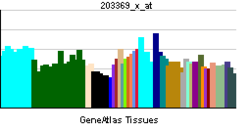- PDLIM7
-
PDZ and LIM domain 7 (enigma) Identifiers Symbols PDLIM7; External IDs OMIM: 605903 HomoloGene: 3980 GeneCards: PDLIM7 Gene Gene Ontology Molecular function • protein binding
• zinc ion binding
• metal ion bindingCellular component • stress fiber
• ruffle
• cytoplasm
• focal adhesion
• actin cytoskeleton
• cell junctionBiological process • ossification
• receptor-mediated endocytosis
• multicellular organismal development
• actin cytoskeleton organization
• cell differentiation
• positive regulation of osteoblast differentiationSources: Amigo / QuickGO RNA expression pattern 


More reference expression data Orthologs Species Human Mouse Entrez 9260 n/a Ensembl ENSG00000196923 n/a UniProt Q9NR12 n/a RefSeq (mRNA) NM_005451.3 n/a RefSeq (protein) NP_005442.2 n/a Location (UCSC) Chr 5:
176.91 – 176.92 Mbn/a PubMed search [1] n/a PDZ and LIM domain protein 7 is a protein that in humans is encoded by the PDLIM7 gene.[1][2]
The protein encoded by this gene is representative of a family of proteins composed of conserved PDZ and LIM domains. LIM domains are proposed to function in protein–protein recognition in a variety of contexts including gene transcription and development and in cytoskeletal interaction. The LIM domains of this protein bind to protein kinases, whereas the PDZ domain binds to actin filaments. The gene product is involved in the assembly of an actin filament-associated complex essential for transmission of ret/ptc2 mitogenic signaling. The biological function is likely to be that of an adapter, with the PDZ domain localizing the LIM-binding proteins to actin filaments of both skeletal muscle and nonmuscle tissues. Alternative splicing of this gene results in multiple transcript variants.[2]
Interactions
PDLIM7 has been shown to interact with TPM2.[3]
References
- ^ Liu Y, Hair GA, Boden SD, Viggeswarapu M, Titus L (Mar 2002). "Overexpressed LIM mineralization proteins do not require LIM domains to induce bone". J Bone Miner Res 17 (3): 406–14. doi:10.1359/jbmr.2002.17.3.406. PMID 11874232.
- ^ a b "Entrez Gene: PDLIM7 PDZ and LIM domain 7 (enigma)". http://www.ncbi.nlm.nih.gov/sites/entrez?Db=gene&Cmd=ShowDetailView&TermToSearch=9260.
- ^ Guy, P M; Kenny D A, Gill G N (Jun. 1999). "The PDZ domain of the LIM protein enigma binds to beta-tropomyosin". Mol. Biol. Cell (UNITED STATES) 10 (6): 1973–84. ISSN 1059-1524. PMC 25398. PMID 10359609. http://www.pubmedcentral.nih.gov/articlerender.fcgi?tool=pmcentrez&artid=25398.
Further reading
- Bach I (2000). "The LIM domain: regulation by association". Mech. Dev. 91 (1–2): 5–17. doi:10.1016/S0925-4773(99)00314-7. PMID 10704826.
- Wu RY, Gill GN (1994). "LIM domain recognition of a tyrosine-containing tight turn". J. Biol. Chem. 269 (40): 25085–90. PMID 7929196.
- Kuroda S, Tokunaga C, Kiyohara Y, et al. (1997). "Protein-protein interaction of zinc finger LIM domains with protein kinase C". J. Biol. Chem. 271 (49): 31029–32. doi:10.1074/jbc.271.49.31029. PMID 8940095.
- Durick K, Gill GN, Taylor SS (1998). "Shc and Enigma are both required for mitogenic signaling by Ret/ptc2". Mol. Cell. Biol. 18 (4): 2298–308. PMC 121481. PMID 9528800. http://www.pubmedcentral.nih.gov/articlerender.fcgi?tool=pmcentrez&artid=121481.
- Guy PM, Kenny DA, Gill GN (1999). "The PDZ domain of the LIM protein enigma binds to beta-tropomyosin". Mol. Biol. Cell 10 (6): 1973–84. PMC 25398. PMID 10359609. http://www.pubmedcentral.nih.gov/articlerender.fcgi?tool=pmcentrez&artid=25398.
- Borrello MG, Mercalli E, Perego C, et al. (2002). "Differential interaction of Enigma protein with the two RET isoforms". Biochem. Biophys. Res. Commun. 296 (3): 515–22. doi:10.1016/S0006-291X(02)00886-0. PMID 12176011.
- Strausberg RL, Feingold EA, Grouse LH, et al. (2003). "Generation and initial analysis of more than 15,000 full-length human and mouse cDNA sequences". Proc. Natl. Acad. Sci. U.S.A. 99 (26): 16899–903. doi:10.1073/pnas.242603899. PMC 139241. PMID 12477932. http://www.pubmedcentral.nih.gov/articlerender.fcgi?tool=pmcentrez&artid=139241.
- Ota T, Suzuki Y, Nishikawa T, et al. (2004). "Complete sequencing and characterization of 21,243 full-length human cDNAs". Nat. Genet. 36 (1): 40–5. doi:10.1038/ng1285. PMID 14702039.
- Gerhard DS, Wagner L, Feingold EA, et al. (2004). "The status, quality, and expansion of the NIH full-length cDNA project: the Mammalian Gene Collection (MGC)". Genome Res. 14 (10B): 2121–7. doi:10.1101/gr.2596504. PMC 528928. PMID 15489334. http://www.pubmedcentral.nih.gov/articlerender.fcgi?tool=pmcentrez&artid=528928.
- Andersen JS, Lam YW, Leung AK, et al. (2005). "Nucleolar proteome dynamics". Nature 433 (7021): 77–83. doi:10.1038/nature03207. PMID 15635413.
- Rual JF, Venkatesan K, Hao T, et al. (2005). "Towards a proteome-scale map of the human protein-protein interaction network". Nature 437 (7062): 1173–8. doi:10.1038/nature04209. PMID 16189514.
- Sangadala S, Boden SD, Viggeswarapu M, et al. (2006). "LIM mineralization protein-1 potentiates bone morphogenetic protein responsiveness via a novel interaction with Smurf1 resulting in decreased ubiquitination of Smads". J. Biol. Chem. 281 (25): 17212–9. doi:10.1074/jbc.M511013200. PMID 16611643.
- Lim J, Hao T, Shaw C, et al. (2006). "A protein-protein interaction network for human inherited ataxias and disorders of Purkinje cell degeneration". Cell 125 (4): 801–14. doi:10.1016/j.cell.2006.03.032. PMID 16713569.
- Barrès R, Grémeaux T, Gual P, et al. (2007). "Enigma interacts with adaptor protein with PH and SH2 domains to control insulin-induced actin cytoskeleton remodeling and glucose transporter 4 translocation". Mol. Endocrinol. 20 (11): 2864–75. doi:10.1210/me.2005-0455. PMC 1892539. PMID 16803868. http://www.pubmedcentral.nih.gov/articlerender.fcgi?tool=pmcentrez&artid=1892539.
- Zhang DW, Li LW, Hu YY (2007). "A novel TAT fusion protein with osteoinductive activity". Med. Hypotheses 68 (5): 1009–11. doi:10.1016/j.mehy.2006.09.057. PMID 17126496.
Categories:- Human proteins
- Chromosome 5 gene stubs
Wikimedia Foundation. 2010.
